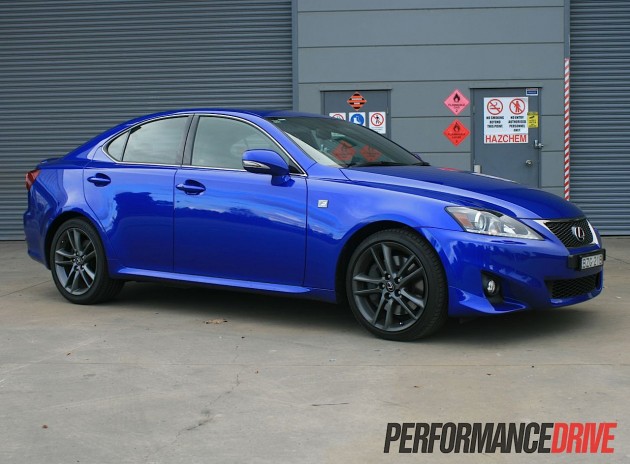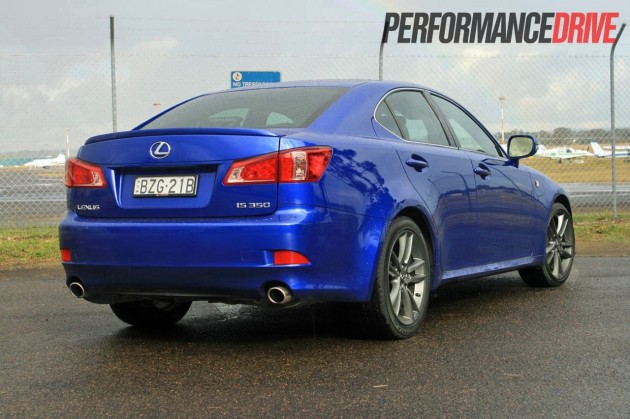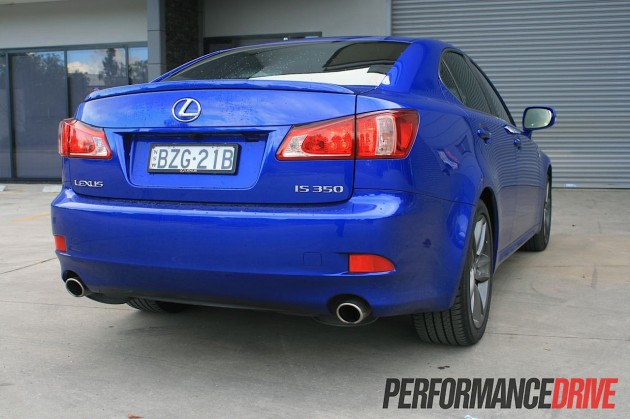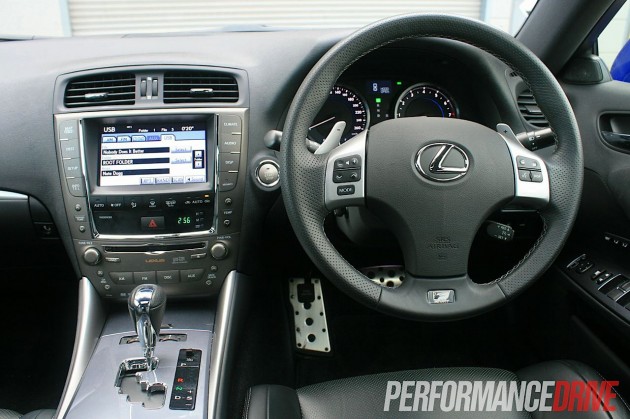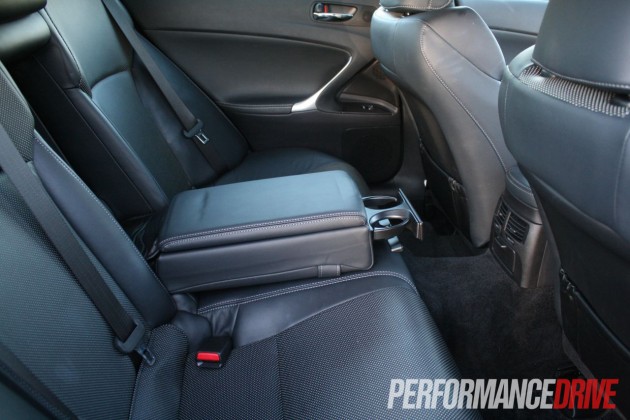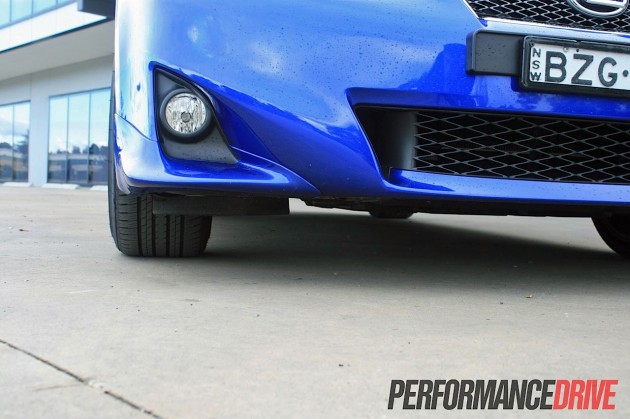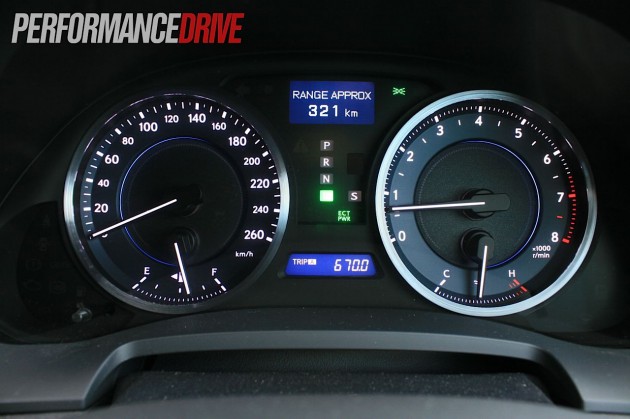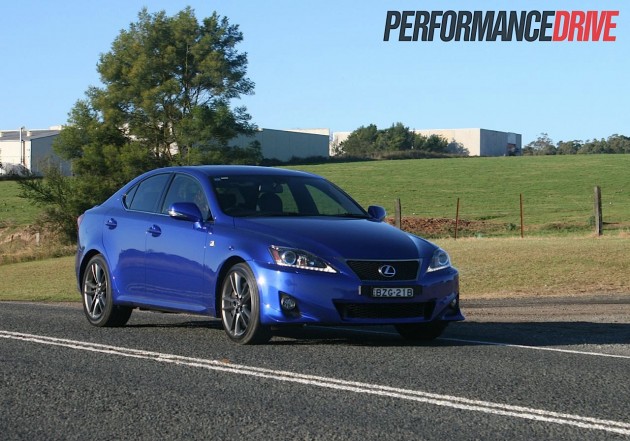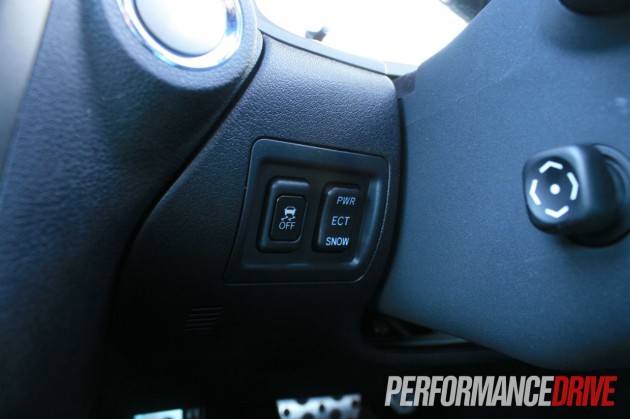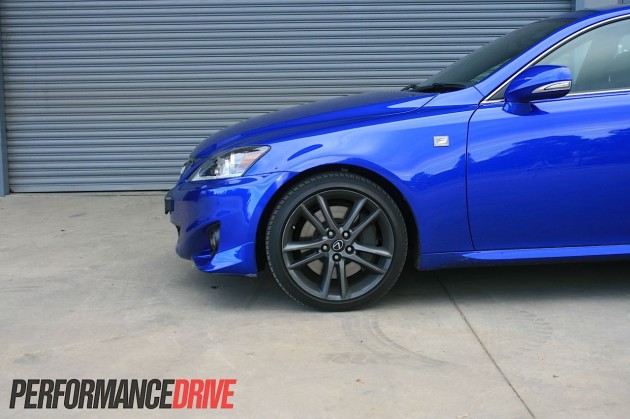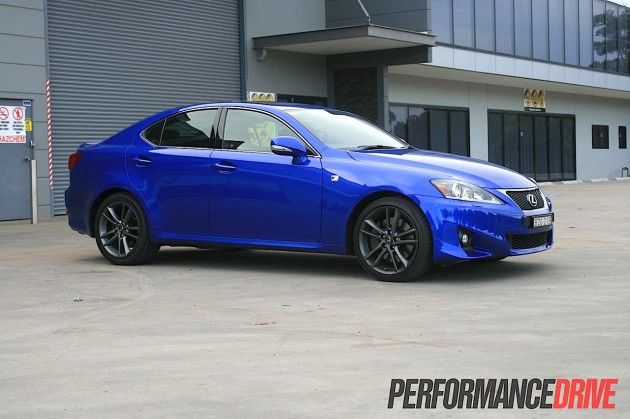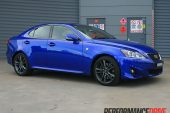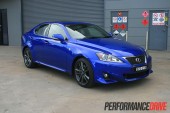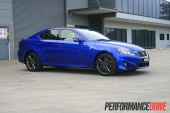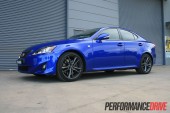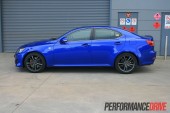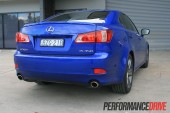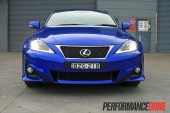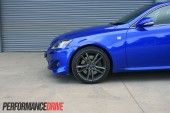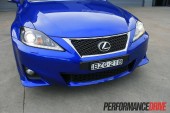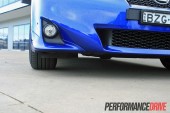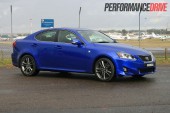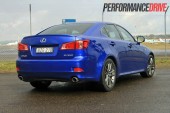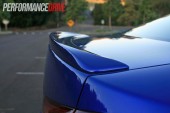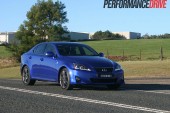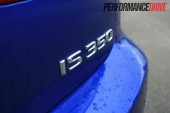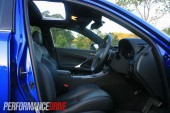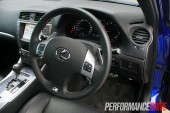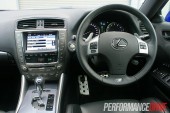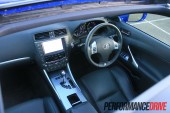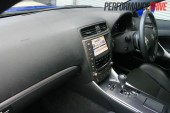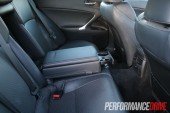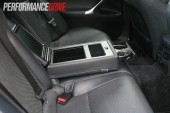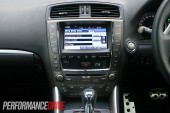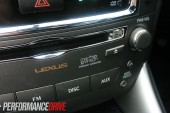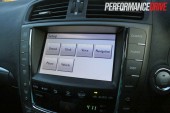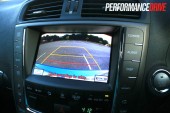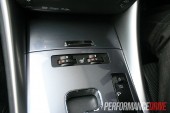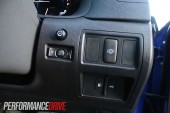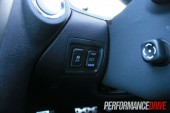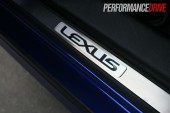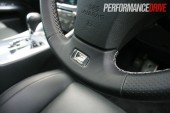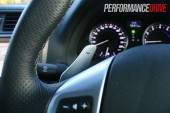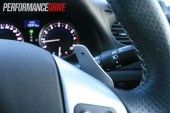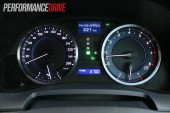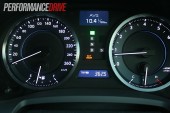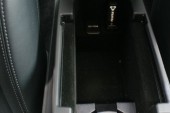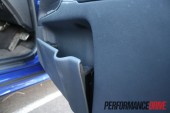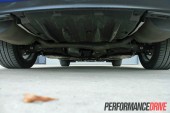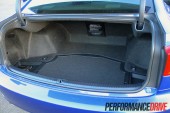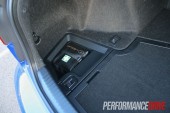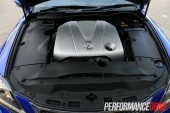If you’re after a very quick, intelligent, and sharp-handling premium sports sedan, there are a few options on the market at the moment. The 2012 Lexus IS 350 F Sport is Japan’s offering.
It’s rear-wheel drive, one of the least expensive, and one of the most powerful options, but most appealingly, it’s the quickest to 100km/h compared to the key players.
2012 LEXUS IS 350 F SPORT – PROS AND CONS
PROS:
- Solid handling
- Lexus refinement and build quality
- Smooth and very punchy/powerful V6 engine
- F Sport bodykit and trimmings give the IS a sharp touch
CONS:
- Poor fuel consumption (we averaged 11.1L/100km and around 540km per 65L tank)
- Dash layout is starting to date
2012 LEXUS IS 350 F SPORT – OVERVIEW
The Lexus IS is the company’s most popular model in Australia, but it has always been the follower to the three popular German rivals, in terms of sales.
Last month, 129 new IS 250s were registered, followed by 56 IS 350s, 15 IS 250C convertibles, and three IS Fs. The sedan range (188) sat as fourth most popular in the segment in May, behind the Mercedes-Benz C-Class (495), BMW 3 Series (425), and Audi A4 (225).
The trend was the same for all of 2011 too, according to the official VFACTS figures. Lexus managed to push 2673 examples of its IS sedan lineup out the door, behind the Merc C-Class (6428), BMW 3 Series (4203), and the Audi A4 (3106).
The current shape IS has been around now since 2005, first introduced with the lower powered IS 250 (2005-2010), then the IS F (2008), and then the IS 350. With the introduction of the IS 350 in 2010, Lexus also introduced the F Sport variant.
(In Australia, the IS 350 is available in three trim levels, like most vehicles in the Lexus showroom. They range from the entry-level Prestige, the racy F Sport, to the range-topping, luxury-focused Sports Luxury.)
The F Sport package brings a high level of performance to the premium sedan, helping it take on the sports versions of all the leading rivals. It can be distinguished by the F Sport aggressive bodykit which is inspired by the kit seen on the awesome Lexus IS F (review here).
In all IS 350 variants, power comes from a meaty 3.5-litre naturally aspirated V6 engine producing a class-leading 233kW and 378Nm (not including the limited edition Volvo S60 Polestar with 242kW).
While it does miss out on the eight-speed automatic seen in the high performance IS F, it does get a smooth six-speed auto with ‘S’ mode and paddle shifters.
Prices start at $71,800 for the F Sport, or $64,800 for the entry-level Prestige, and $81,300 for the Sports Luxury.
2012 LEXUS IS 350 F SPORT – ACCOMMODATION AND EQUIPMENT
Standard features for the F Sport include sports-tuned suspension, bigger brakes, and a number of ‘F’-themed interior and exterior highlights.
Inside, there are a pair of electronically adjustable leather bucket seats, with heating functions, and two similarly bolstered rear seats with a third middle seat doubling as a flip-down table with cup holders.
The rest of the interior is a typical Lexus affair, with a fine cloth headliner, and hints of chrome and aluminium throughout the dash and door trims. There’s also a healthy dose of technology, chief among which is the multimedia touch-screen interface. It’s surrounded by main menu buttons around the screen.
We found the controls and layout easy to understand, albeit slightly overwhelming at first. The satellite navigation system is quite easy to use as well, however, the software did seem a little dated, placing us in a field at times when we were actually on a relatively key road.
The overall interior is a little on the small side, in terms of this market segment. This is partly due to those comfy and highly supportive front bucket seats, which are almost identical to those seen in the IS F (without the ‘F’ embroidery). As a consequence, rear legroom can be tight if the front seats are slid back.
Other features for the F Sport include HID headlights with cleaners, LED daytime running lights, auto-retract and self-dimming exterior mirrors, rain-sensing wipers, an electronically adjustable steering column, and a high quality Mark Levinson 14-speaker premium sound system.
2012 LEXUS IS 350 F SPORT – DESIGN AND SAFETY
You could almost mistake the IS 350 F Sport for the full-blown IS F if you’re not careful. The kit includes a sharp bodykit with front and rear spoilers, an aggressive black mesh front grille and gaping air intakes, and 18-inch dark grey alloy wheels – swapping the twin five-spoke wheels for IS F mesh-style items could easily fool those in the know.
Obvious highlights which are diluted on the F Sport over the IS F include the twin-outlet exhaust tips – as opposed to the quad setup on the IS F – and the slightly less bulging bonnet, particularly towards the front.
We think Lexus has done a good job with the styling, and despite the foundations being eight years old, the F Sport manages to fit in well with the rivals. It’s not over-the-top in any one area, while front and rear proportions flow and blend in well with Lexus’s current design language.
As for safety, a three-mode Vehicle Dynamic Integrated Management (VDIM) traction and stability control system – with Power and Snow driving modes – will keep you out of trouble, while eight SRS airbags, ABS with electronic brake force distribution, and Lexus brake assist will try and reduce the blow if things get out of hand.
Australia’s ANCAP has previously awarded the IS five stars, but it hasn’t tested the 350 variant specifically. In 2005, the IS achieved 33.4 out of 37 overall.
2012 LEXUS IS 350 F SPORT – ON THE ROAD
It may not be the snorting and grunting IS F, but the IS 350 F Sport is definitely not to be taken lightly. The 233kW hits hard when the accelerator is pushed to the floor, resulting in an almighty shove in the back, which keeps on shoving until you very quickly realise you’re breaking the law.
We clocked 0-100km/h a number of times, with the best result coming from building the revs while resting on the brake pedal. In the normal ‘D’ transmission setting, the sprint came up in a surprisingly brisk 5.47 seconds, and just 5.44 seconds by doing the same thing in ‘S’ mode.
This puts it as the quickest accelerating premium sports sedan currently on the market. And it feels as if it deserves every bit of that accolade.
The specially-tuned suspension in the F Sport is firm, which is exactly what you should expect on a sports variant – some experts have criticised it for being too firm, but we think perhaps those critics are getting a bit long in the tooth.
The setup allows for sharp and direct handling, while the pinpoint steering gives excellent feedback on what the wheels are doing. If we had any criticism to the handling it’s that there can be a touch of understeer on longer bends when pushed.
This trait brings us to the traction and stability control system. It’s similar to the system used on the first-gen IS F, with the less-than-favourable electronic-type limited-slip differential. Even in PWR ECT mode, the systems don’t really allow you to change the attitude or shift the weight of the car very easily; the electronics come into play very early, well before any sort of fun or slip is experienced.
In terms of safety, the system is simply superb and virtually fool-proof. You can plant the throttle at the most inappropriate of times, and the electronics will reduce power, brake individual wheels, and generally sort out everything for you to make sure you get around the corner in complete safety and confidence.
If you plan on venturing to a track for example though, the systems are likely to become a little frustrating. It doesn’t allow for enough ‘play’, so to speak. And even if you turn the traction control off, the stability stays on, while the differential becomes an open-style diff. This means you’ll be leaving long single black lines of rubber on every corner.
Apart from these systems, the IS 350 F Sport is an engaging, well-sorted, confident piece of machinery. The fact that the chassis is engineered for a V8 – in the case of the IS F – you can feel it’s never working beyond or even near its threshold.
The V6 engine doesn’t sound quite as throaty as it does in the excellent new Lexus GS 350 (review here), however, it gives off a refined V6 roar. Using the paddle shifters will also get you a faint blip on the downshifts, adding to the eagerness of this powertrain combination.
It’s always good to see manufacturers fitting brakes that are more than capable, in relation to the potential acceleration and speed, onto their cars. And the IS 350 is a perfect case of this.
There’s no fade, while the initial bite is strong enough to send the rear centre armrest collapsing down onto the rear bench. Even at high speeds, the braking system is almost over-engineered for the car, and easily capable of wiping off speeds time and time again.
2012 LEXUS IS 350 F SPORT – VERDICT
The only thing that makes this a hard one to pick is the rivals in this class. The new BMW 335i with its twin-turbo inline six, both quick and fuel efficient, to the interesting Volvo S60 T6 with its all-wheel drive and very nice interior; there are plenty of good options in this category.
If you want the quickest out of the lot, the 2012 Lexus IS 350 is what you need. It offers proper grin-inducing levels of acceleration – it’s as quick as some of the much more expensive dedicated sports cars on the market – while the F Sport with its aggressive bodykit and athletic suspension and highlights only add to the definitive sports sedan formula.
The best part is, at $71,800, it’s a downright bang-for-your-buck bargain.
If you’ve always loved the IS F but can’t quite stretch to that price bracket, the IS 350 F Sport brings similar levels of performance and speed, and looks, at half the price. An excellent all-round performer.
2012 LEXUS IS 350 F SPORT – THE COMPETITORS
BMW 335i Sport – 3.0-litre turbocharged inline six, 225kW/400Nm – 1585kg – $91,900
The new 3 Series is regarded as the most complete sports sedan on the market. Great acceleration and fuel economy; 0-100km/h 5.5 seconds, 7.2L/100km.
Audi A4 3.2 FSI – 3.2-litre petrol V6, 195kW/330Nm – 1610kg – $91,000
The A4 is the third best-selling premium sedan in Australia. With those neat looks, all-wheel drive, and a powerful V6 engine, it’s easy to see why it’s one of the favourites.
Mercedes-Benz C 350 Coupe – 3.5-litre petrol V6, 225kW/370Nm – $94,900
The ‘350’ is only available as a Coupe, which is a shame as the 225kW V6 would sit perfectly up against these sports sedan rivals. 185kW C 300 sedan is the next best thing.
Volvo S60 T6 R-Design – 3.0-litre turbocharged inline six, 224kW/440Nm (Polestar 242kW/480Nm) – 1684kg – $72,990 (Polestar $82,990)
The underdog here, the all-wheel drive T6 R-Design is a great-looking proposition. It’s also very smart, and safe, of course, while the Ford-sourced turbo six is silky smooth.
2012 LEXUS IS 350 F SPORT – SPECIFICATIONS
MODEL
2012 Lexus IS 350 F Sport
ENGINE
3.5-litre naturally aspirated V6, variable valve timing
ENGINE SIZE / COMPRESSION RATIO
3456cc / 10.8:1
BORE X STROKE
94mm x 83mm
POWER
233kW@6400rpm, 378Nm@4800rpm
POWER TO WEIGHT RATIO
7.0: 1 (kg:kW)
KERB WEIGHT
1645kg
HEIGHT / WIDTH / LENGTH
1425mm / 1800mm / 4585mm
DRIVETRAIN
Six-speed auto transmission, rear-wheel drive
BRAKES
F: 334mm ventilated discs
R: Ventilated discs
WHEELS / TYRES
Front: 18 x 8-inch alloy, 225/40 R18
Rear: 18 x 8.5-inch alloy, 255/40 R18
FUEL TANK CAPACITY
65 litres
FUEL TYPE
95 RON Premium
FUEL CONSUMPTION
Tested average: 11.1L/100km
Official average: 9.4L/100km
PERFORMANCE
0-100km/h: 5.4 seconds (tested)
PRICED FROM
$71,800
WARRANTY
Four-year/100,000km
